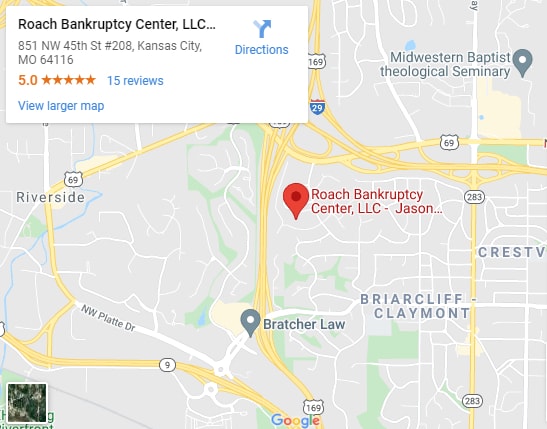Bankruptcy Attorney in Kansas City, MO
In the event that a company is unable to fulfill its financial obligations or make payments to its creditors, it will submit a petition to become bankrupt. A petition is submitted to the court for the same where all of the company’s outstanding debts are tallied and paid out from the company’s assets, if not in full from the company’s assets.
The process of declaring bankruptcy in Missouri is, for the most part, identical to the process of declaring bankruptcy in any other state. The process of filing for bankruptcy is governed by federal law, not the law of the state of Missouri, and it functions by severing the contractual ties that you have with your creditors; this enables you to start over financially.
However, the laws of Missouri have a significant bearing on the situation. They decide which of your possessions you can keep even after filing for bankruptcy. You will also need to be familiar with additional filing information.
Our Missouri bankruptcy lawyers at the Roach Bankruptcy Center, LLC, will assist clients in getting out of their difficult financial burdens. We have years of experience helping people get out of difficult financial situations and offering the best legal solutions. The laws governing bankruptcy are subject to change over time, but it is possible that you will still be eligible for Chapter 13 bankruptcy. Get in touch with one of our consumer bankruptcy attorneys right away to acquire further information and get a free initial consultation.
Why do I need a Bankruptcy Attorney in Kansas, MO?
 A bankruptcy attorney with vast knowledge on bankruptcy, drafting legal documents, and representing clients in court. As your guide through the bankruptcy process, a lawyer can provide guidance on the following:
A bankruptcy attorney with vast knowledge on bankruptcy, drafting legal documents, and representing clients in court. As your guide through the bankruptcy process, a lawyer can provide guidance on the following:
- Whether or not to declare bankruptcy
- What type of bankruptcy should be filed
- How the bankruptcy procedure functions
- Which court-issued forms must be filled out
- What types of debts are eligible for reduction or elimination
- Whether you will be able to keep your home, vehicle, and other property after the bankruptcy case has been resolved.
Overall, a bankruptcy attorney can guide you on the correct legal path. If you handle your bankruptcy case without an attorney, you may make legal errors with long-term financial repercussions.
If you hire a bankruptcy attorney, you can anticipate the following:
- A legally binding agreement or contract between you and the attorney. The agreement will likely include a summary of the attorney’s services.
- A description of payment arrangements. For instance, will the attorney charge an hourly or flat rate? What will the costs be?
- Ongoing conversations. You will discuss the attorney’s handling of your case.
- An agreement. You will determine how and how frequently the attorney will provide you with case updates.
- A catalog of documents. The attorney should provide you with a comprehensive list of the required documents for your bankruptcy case.
Basic Steps in Filing Chapter 13 Bankruptcy
1. Ensure that Chapter 13 is the best option.
The majority of individuals file for Chapter 7 or Chapter 13 bankruptcy. Both have distinct characteristics that help filers solve specific problems. In Chapter 13 bankruptcy, for instance, you can catch up on missed mortgage or auto loan payments to prevent home foreclosure or vehicle repossession. Chapter 7 bankruptcy lacks a comparable option.2. Analyze your debt.
If your debts are excessive, you may not be eligible. The amount of debt you can owe under Chapter 13 is limited. Additionally, certain debts, including tax, mortgage, and domestic support arrears, must be paid in full over the course of the three- to five-year repayment plan. If you do not have sufficient income to make the required payment, you may not be able to propose a workable solution.3. Place a value on your property.
Before filing for bankruptcy, you will need to know how much property you own and how much can be protected by exemptions. Although you can keep all of your property, you must pay the value of your nonexempt property to certain creditors. The value of the non-exempt property will be factored into the Chapter 13 repayment plan amount.4. Gauge your income.
Your income must be sufficient to cover your monthly living expenses, all of the debt you are required to pay under your plan, and the value of any nonexempt property you intend to retain. If you do not have sufficient income, the court will not allow you to proceed.5. Complete the bankruptcy forms.
After determining your eligibility, you must record all of your financial information on official bankruptcy forms and create a repayment plan.6. Take the mandatory pre-filing course.
Before filing for bankruptcy, individuals must complete a credit counseling course. You will receive a certificate upon completion that you will include with your bankruptcy paperwork.7. Submit your paperwork and pay a fee.
When everything has been inspected and verified, it is time to submit your forms, certificate, and plan to the bankruptcy court to initiate the process. In addition, you must pay the bankruptcy filing fee.8. Provide evidence of your income and other assets to the trustee.
After you file, the information on your official documents is validated against bank statements, pay stubs, and tax returns, among other documents (called 521 documents).9. Attend two public hearings.
You will meet with the bankruptcy trustee appointed to administer your case at the 341 meeting of creditors a few weeks after filing. The trustee will examine your identification documents, official forms, repayment plan, and supporting documentation. Creditors can also ask questions at this meeting (but rarely do). Shortly after this meeting, you or your attorney will be required to attend a confirmation hearing during which the bankruptcy judge will decide whether to confirm (approve) your plan. A creditor can object beforehand by filing an opposition with the court. The judge will decide whether or not to approve the plan after reviewing written objections and hearing any arguments presented at the hearing.10. Make payments.
Within 30 days, you must begin making payments according to your repayment plan. If you fail to make payments, your case will be dismissed.11. Participate in the post-filing course.
Before completing your repayment plan, you must complete the second required class, debtor education, and submit the certificate.12. Get your bankruptcy discharge.
After completing your plan, you will be discharged from bankruptcy. Some unsecured debts, including student loan balances, are not dischargeable. As long as you’ve paid the agreed-upon amount, you’re finished. Congratulations! It is common for situations to arise that will require you to return to court. For example, if your income decreases, you may be able to petition the court to reduce your payment (but not always).Facing Imminent Foreclosure?
We can help save your home! Even if time is running out, we’ll find a way. Find out how by speaking with our bankruptcy lawyer in Kansas City, Missouri today.
Call Us Today! (816) 454-5555
Trusted Bankruptcy Lawyers In Missouri
Want to save your home or car? We will help you file bankruptcy and choose the best type to ease your financial burdens!
Contact Roach Bankruptcy Center, LLC today via our website to schedule a free initial consultation. Consult our Kansas City bankruptcy lawyers to find out today about your bankruptcy options and know the basic steps in filing them. Filing Chapter 7 or 13 bankruptcy in Missouri offers both individuals and families a “fresh start”.
